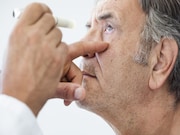Most adults with diabetes, including high-risk patients, seen by a primary care doc in previous year
FRIDAY, Feb. 15, 2019 (HealthDay News) — Screening for diabetic retinopathy (DR) in primary care settings has the potential to reach most U.S. adults with diabetes, according to a brief report published online Jan. 31 in JAMA Ophthalmology.
Diane M. Gibson, Ph.D., from City University of New York, used data from the 2016 National Health Interview Survey to identify 3,229 U.S. adults with self-reported diabetes to estimate the percentage of patients who have regular contact with primary care physicians and who could potentially receive timely screening for DR in primary care settings.
Using weighted percentages of the full sample, Gibson found that 15.3 percent of patients had lower income, 19.7 percent had lower educational levels, 15.4 percent were African-American, 16 percent were Hispanic, 6.1 percent were uninsured, and 50.1 percent were female. The mean age was 60.1 years, and 87.7 percent visited a primary care physician in the previous year. Of patients who did not receive a dilated eye examination in the previous year, 82.2 percent visited a primary care physician during the year. More than 78 percent of each high-risk subgroup, except for the uninsured, visited a primary care physician in the previous year.
“Screening for DR in primary care settings has the potential to provide timely screening to a large portion of U.S. adults with diabetes because most U.S. adults with diabetes, including those at high risk of missing recommended eye examinations, have regular contact with primary care physicians,” Gibson writes.
Copyright © 2019 HealthDay. All rights reserved.








